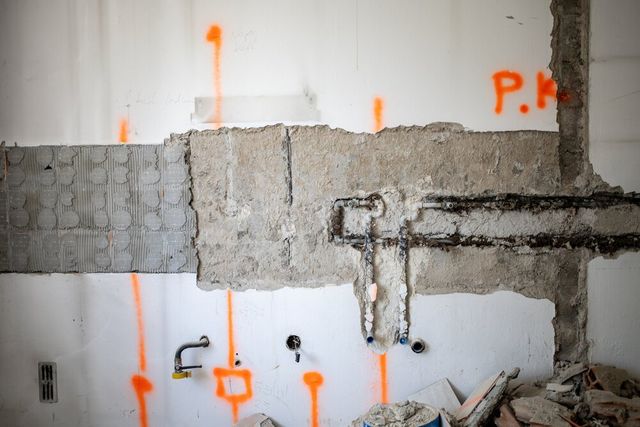Checking Out the Midst: A Comprehensive Guide to Concrete Scanning and Its Diverse Applications
In the world of construction and framework growth, the precise procedure of concrete scanning holds an essential function in ensuring the structural integrity and security of jobs. As modern technology proceeds to advance, the applications of concrete scanning have actually increased much past simple surface-level evaluations.
Value of Concrete Scanning
Comprehending the importance of concrete scanning is important in making sure the safety and stability of frameworks throughout construction and restoration projects. Concrete scanning uses innovative modern technologies such as ground-penetrating radar (GPR) and electro-magnetic induction to spot ingrained items, spaces, or various other abnormalities within concrete structures.
Moreover, concrete scanning plays a critical function in making sure compliance with building regulations and policies that mandate the defense of existing architectural elements throughout building and construction tasks. By properly drawing up the interior composition of concrete, scanning technologies allow construction specialists to make educated decisions that maintain the architectural stability and toughness of buildings and infrastructure projects. In essence, the importance of concrete scanning depends on its capability to safeguard both the structural stability and the employees involved in building and construction endeavors.
Technologies Used in Concrete Scanning
Concrete scanning relies upon innovative modern technologies such as ground-penetrating radar (GPR) and electro-magnetic induction to properly spot embedded objects and anomalies within concrete structures. Ground-penetrating radar runs by emitting high-frequency electromagnetic waves right into the concrete. When these waves run into different materials or spaces within the concrete, they recover to the surface area, permitting the GPR system to create an in-depth subsurface photo. This modern technology is particularly efficient in situating rebar, post-tension cable televisions, channels, and other items embedded in concrete.
Electromagnetic induction, on the other hand, works by producing magnetic fields around a concrete structure with a transmitter coil. When steel objects exist within the concrete, they interrupt these electro-magnetic fields, triggering eddy currents to stream via the metal. By measuring the changes in the magnetic fields with a receiver coil, the system can identify the place of metallic objects in the concrete.
These cutting-edge innovations play an essential function in non-destructive screening, making certain the safety and integrity of concrete frameworks in different industries.
Applications in Construction Sector
Within the building and construction industry, concrete scanning modern technology locates diverse applications that boost job effectiveness and security. In addition, concrete scanning is made use of for situating voids, such as air pockets or areas of degeneration within concrete, which can endanger the total toughness of a structure. Concrete scanning plays a vital duty in quality control by confirming the thickness of concrete covers over reinforcement, making sure conformity with style specs and criteria.

Safety And Security Advantages of Concrete Scanning
In the world of building safety, the article execution of concrete scanning innovation provides a vital advantage in preemptively identifying possible risks and fortifying structural integrity. By making use of innovative scanning techniques such as ground-penetrating radar (GPR) and electro-magnetic induction, construction teams can precisely situate rebar, post-tension cable televisions, channels, and various other hidden objects within concrete frameworks. This proactive technique considerably lowers the danger of unintentional strikes throughout exploration, reducing, or coring activities, consequently preventing costly problems, injuries, and project hold-ups.
Additionally, concrete scanning boosts employee safety and security by giving real-time info regarding the structural problem of concrete components. By attending to possible security concerns without delay, concrete scanning contributes to developing a safe functioning setting and alleviating the probability of structural failings or mishaps on building and construction sites.
Future Fads in Concrete Scanning
Emerging improvements in scanning innovation are positioned to change the area of concrete assessment and analysis. By utilizing the power of AI, these systems can evaluate substantial amounts of data accumulated during scanning processes to give more precise and detailed understandings right into the problem of concrete frameworks.
Another considerable pattern is the advancement of more portable and easy to use scanning devices. Miniaturization of scanning equipment allows for much easier accessibility to constrained spaces and remote locations, making examinations more efficient and detailed. Furthermore, innovations in cordless communication modern technologies enable real-time information transfer and evaluation, facilitating quicker decision-making procedures.
Furthermore, there is a growing emphasis on sustainability in concrete scanning technologies - RainierGPR Concrete Scanning. Producers are significantly including environmentally friendly materials and energy-efficient functions right into their tools to decrease ecological impact. These future trends are readied to improve the efficiency, precision, and sustainability of concrete scanning practices, shaping the market's future landscape
Final Thought
In final thought, concrete scanning plays an essential function in the building market by ensuring the safety and security and performance of numerous tasks. By making use of sophisticated modern technologies, such as GPR and radar imaging, experts are able to properly identify potential threats within concrete frameworks. The have a peek at this website applications of concrete scanning are huge and remain to evolve, making it a vital tool for keeping the integrity of structures and infrastructure. As technology advancements, the future of concrete scanning holds appealing growths for improving building procedures.
